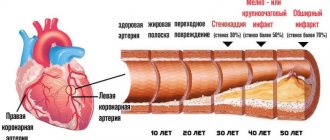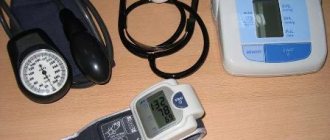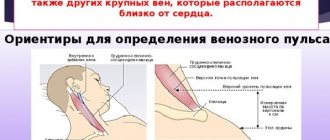The secret of longevity is in blood vessels
If they are clean and healthy, then you can easily live 120 years or even more
To learn more…
In a completely healthy person, the normal blood pressure is 120/80 mm Hg. Art., but this indicator may not always be. If the deviation from the norm is smaller, the problem is called hypotension, and if it deviates more, it is called hypertension. What to do if the pressure is 110 over 90, what medications to take and why the condition is dangerous is described in the article.
What do the indicators mean?
A blood pressure of 110 over 90 is considered diastolic hypertension. With it, the difference between systolic and diastolic blood pressure is significantly lower than normal.
The optimal difference between the minimum and maximum normal limits should not exceed 50 mmHg. Insufficient difference or gap indicates insufficient pulse pressure.
Most often, many athletes encounter this condition. Experts say that for them this is not considered a pathology. Because everything depends on frequent and intense training. With a strong load on the body, blood pressure rises, but after rest it returns to normal.
Another reading of 110/90 may be associated with alcohol consumption. The pressure begins to change as the body tries to remove excess alcohol from the blood. And such numbers indicate that a hangover has begun.
If we look at statistics, such indicators are available in adolescence and young adulthood. Doctors say there is no need to worry. This condition often occurs due to fatigue and lack of sleep.
If we consider medical statistics, such blood pressure is more often observed in women after 45 years of age. This is due to the onset of hormonal changes during menopause.
Optimally normal blood pressure is considered to be 120 to 80 mm Hg. Art.
And if the difference between the upper and lower pressures is small 11090, what does this mean?
Valentina Kamets
Blood pressure is the pressure of blood on the walls of blood vessels - veins, arteries and capillaries. Blood pressure is necessary to ensure that blood can move through the blood vessels. The value of blood pressure (sometimes abbreviated as blood pressure) is determined by the strength of the heart contractions, the amount of blood that is released into the vessels with each contraction of the heart, the resistance that the walls of blood vessels provide to the flow of blood and, to a lesser extent, the number of heart contractions per unit of time. In addition, the value of blood pressure depends on the amount of blood circulating in the circulatory system and its viscosity. Blood pressure is also affected by pressure fluctuations in the abdominal and thoracic cavities associated with respiratory movements and other factors. When blood is pumped into the heart, the pressure in it increases until the blood is thrown out of the heart into the vessels. These two phases - pumping blood into the heart and pushing it out into the vessels - constitute, medically speaking, the systole of the heart. Then the heart relaxes, and after a kind of “rest” it begins to fill with blood again. This stage is called cardiac diastole. Accordingly, the pressure in the vessels has two extreme values: the maximum - systolic, and the minimum - diastolic. And the difference in the magnitude of systolic and diastolic pressure, or rather, fluctuations in their values, is called pulse pressure. The normal systolic pressure in large arteries is 110-130 mm Hg. Art. , and diastolic - about 90 mm Hg. Art. in the aorta and about 70 mm Hg. Art. in large arteries. These are the same indicators that we know as upper and lower pressure. Normally, the difference between systolic blood pressure (BP) and diastolic blood pressure is 30-60 mmHg. st
In addition to dry numbers, your well-being is extremely important. If everything is OK (no fatigue, shortness of breath, swelling), then you shouldn’t pay attention to this small difference. But you should pay attention to the diastolic blood pressure figure - 90 mmHg
Art. Strictly speaking, repeated increases in blood pressure over 139/89 indicate the presence of hypertension. To resolve all issues, I recommend undergoing 24-hour blood pressure monitoring. Normal pressure has a range within which changes are allowed: systolic blood pressure from 90 to 135, diastolic (“lower” blood pressure from 60 to 85. Therefore, there is no need to fight this. This is the norm and you should not link your poor health to blood pressure numbers. Maybe you just tired... 2. When you get a small difference between systolic and diastolic pressure when measuring blood pressure (which sometimes happens when using electronic tonometers), then you just need to remeasure. This is a measurement error. 3. A decrease in pulse pressure (systolic blood pressure decreases, diastolic blood pressure decreases normal or increases) is observed with a decrease in cardiac output: myocardial damage (myocarditis, myocardial dystrophy, cardiosclerosis) or compression of the heart (exudative or constrictive pericarditis), narrowing of the aortic ostium (HCM)... 4. To understand the essence: Systemic blood pressure is determined mainly by the relationship between cardiac output and total peripheral vascular resistance, therefore, for the occurrence of arterial hypertension, an increase in cardiac output (stroke volume x heart rate), peripheral vascular resistance, or both of these variables is necessary. Most often, with arterial hypertension, the peripheral vascular resistance is increased. 1). Systolic blood pressure depends on three factors: stroke volume of the left ventricle of the heart, maximum ejection velocity and distensibility of the aortic walls. 2). Diastolic blood pressure is determined by two parameters: total peripheral vascular resistance and heart rate. Your doctor will usually take your blood pressure two or three times in a row. Why? Because the first measurement sometimes gives an overestimated value due to the reaction of blood vessels to compression - squeezing the arm with a cuff. The second and third dimensions can be considered correct if they coincide well with each other
Nafanya brownie
This difference is called pulse pressure. In this case, headaches may bother you. With these pressure figures, I would recommend a diuretic, including herbs (dill, parsley, lingonberry leaf) Get well soon!
Symptoms and signs
When a patient’s health deteriorates, the poor condition is often associated with various other diseases, but not with blood pressure, and this is a big mistake.
The following symptoms may indicate that there is a malfunction of the cardiovascular system and other internal organs in the body:
- aching or pressing headache;
- cardiopalmus;
- nausea;
- feeling of heaviness in the chest;
- chills;
- dizziness;
- dyspnea;
- general loss of strength;
- pale skin;
- chilliness of the limbs;
- the face turns red.
Therapy with a doctor
Your doctor will help you solve blood pressure problems with similar values. Pharmaceutical drugs are prescribed for medicinal purposes. The following diuretics are considered in demand:
- Diacarb;
- Furosemide;
- Hypothiazide.
Diuretics are prescribed only by a specialist, because along with the liquid they remove useful microelements from the body - magnesium, calcium.
Often therapy includes taking diuretics with potassium-containing drugs (Panangin, Asparkam).
If blood pressure worries only periodically, then tablets with antihypertensive properties are suitable for treatment. The most popular medications:
- Moxonidine;
- Methyldopa;
- Albared.
The above remedies restore the functioning of the nervous system, as a result of which the blood vessels narrow and spasms disappear.
To permanently normalize blood pressure, ACE inhibitors are taken:
- Enalapril;
- Ramiril;
- Perindopril.
If such medications are prescribed, the therapy will be long-term, and in some cases, the pills will have to be used for the rest of your life.
Depending on the patient’s condition and the presence of severe symptoms, the doctor may prescribe drugs from the group of beta blockers. This list includes:
- Valsartan;
- Losartan;
- Eprosartan.
Capsules are taken daily, once a day. To consolidate the positive result, it is recommended to take the medicine for 1-2 months. This medication has a minimal number of side effects. Sometimes complex treatment with different drugs that affect different systems and organs is required.
If you have chest pain, you can use Corvalment or Nitroglycerin, placing them under your tongue. It is possible to apply Corvalol drops once. Validol, motherwort and valerian are used for calming. Medicines are prescribed only by a doctor, excluding any contraindications for use.
Heart rate indicators
If the pressure is 110 over 90, and the pulse is 100–110 beats per minute, then this indicates the appearance of tachycardia. This symptom can be either an independent heart rhythm disorder or a sign of other diseases. In any case, tachycardia cannot be ignored.
If the pulse is determined at the upper limit of normal and is 90 beats per minute, and the patient does not feel sick, then there is no need to worry.
A normal heart rate should be 70–90 beats per minute.
Why does my heart rate increase? This happens because the body tries to compensate for the insufficient supply of oxygen to the internal organs and normalize the pressure on its own.
Symptoms of a high “lower” indicator
Typically, isolated diastolic pressure is determined during a medical examination or during treatment of another disease, since the initial stage is asymptomatic.
Even when visiting a therapist and measuring blood pressure, patients rarely take elevated lower readings seriously, since it is believed that only an increase in the upper readings is dangerous.
Isolated diastolic pressure contributes to increased tension of the heart muscles and impaired cardiac circulation.
As a result, the permeability of heart vessels changes, which leads to irreversible pathological changes and thrombus formation.
It is especially dangerous when a patient, after a certain period of time, discovers elevated diastolic numbers and begins to take medications that lower blood pressure (hypotensive drugs) without consulting a physician.
As a result of such self-medication, the upper levels, which were previously normal, can quickly decrease.
Causes
If the tonometer shows 110 to 90 mmHg. Art., systolic pressure is considered low, and diastolic high. These indicators indicate possible abnormalities in the body associated with the heart and vascular system.
In pregnant women
- kidney problems;
- stress;
- late toxicosis or gestosis;
- hormonal disorders;
- multiple pregnancy;
- hereditary predisposition;
- fluid retention in the body.
In adults and elderly
- improper use of antihypertensive drugs;
- renal failure;
- atherosclerosis;
- musculoskeletal disorders;
- increased physical activity;
- overweight.
In older people, any changes in blood pressure can be seriously life-threatening.
Although the generally accepted norm of blood pressure for adults is 120 to 80 mm Hg. Art., in older people it can be 140 to 100.
In children and adolescents
- pathologies of internal organs;
- physical exercise;
- stress;
- sedentary lifestyle;
- taking medications, such as oral contraceptives;
- excess weight;
- alcohol abuse and smoking;
- oncological diseases.
At a young age, a blood pressure of 100 to 70 mm Hg is considered normal. Art.
In men
Doctors say that in males such pressure can be caused by physiological characteristics. But this also includes reasons such as:
- excess weight;
- passive lifestyle;
- tobacco and alcohol abuse;
- stress.
Rules for a healthy lifestyle to normalize blood pressure
- Be active, play sports. It doesn’t have to be long or too intense. The load should be pleasant, moderate and regular;
- Lose weight if you are obese;
- Eat balanced and healthy foods and maintain reasonable intervals between meals. Avoid fast food, spicy and fatty foods, salt, sweet soda and caffeinated products. The diet should include lean fish and meat, fruits and vegetables, cereals, wholemeal bread;
- Stop smoking and drinking alcohol;
- Take vitamin complexes;
- Avoid stress, control emotions, learn to relax.
Along with the medications prescribed by your doctor, you can take herbal infusions: valerian, motherwort, lemon balm. They are soothing and help to slightly reduce blood pressure.
What will help normalize blood pressure?
First of all, it is imperative to reconsider your lifestyle and adjust it.
You need to start with your appearance - this means that you need to get rid of excess weight.
It is advisable to stop drinking alcohol and tobacco. These habits negatively affect the entire body.
Movement is life. Be sure to include physical activity in your daily routine, spend more time in the fresh air and allocate more time for sleep.
Here we also cannot forget about nutrition. Balance your diet and eliminate unhealthy foods. It is advisable to consume more dairy foods and lean meat with fish. This will help improve blood circulation.
As for the various available drugs, it is better to refuse such amateur activities. Medicines must be individually selected and prescribed only by a doctor.
Some patients trust old folk and proven methods. Yes, this will help normalize blood pressure for a certain period of time, but if pathological changes have already occurred in the body, it is very difficult to stabilize it. What about folk methods for correcting blood pressure? Among followers of a healthy lifestyle, the following are popular:
- vegetable juices;
- herbal remedies that help remove excess fluid from the body;
- sedative plants – mint and lemon balm.
Compotes made from lingonberries, rowan berries, blueberries, carrots and beets help well. You can also take plants that have a diuretic effect - horsetail, corn silk, green tea.
Only after diagnosing the cause of high lower pressure can appropriate therapy be prescribed.
Home treatment
Traditional medicine recipes help fight the problem of blood pressure and improve a person’s condition. To lower diastolic pressure readings:
- Birch buds. Dry raw materials are poured with a glass of boiling water and infused. The medicine is taken 3 times a day, 3 tbsp. l., before meals.
- Decoction. Elecampane and ginseng are taken in equal proportions. An excellent substitute would be pumpkin decoction with honey. Plants and vegetables increase vascular tone.
- Motherwort. Add 1 tbsp to 200 ml of boiling water. l. dried plants for 30 minutes. After steaming, the infusion is divided into 3 servings. The product should be taken in the evening, before bedtime.
Low blood pressure needs to be increased. This can be done without the use of medications. For mild forms of the disease, it is better to use the following folk recipes:
- Beverages. Strong tea, coffee, and dry red wine will improve your performance well. A piece of dark chocolate will also go well with them.
- Massage. During surges in blood pressure, strong massaging of the earlobes has a good effect on the body - until it hurts, which can be tolerated. The values will begin to decrease after 10 minutes.
- Juice. Blood pressure worries many expectant mothers. During pregnancy, it is recommended to drink birch and cranberry juice little by little throughout the day.
If there is no severe discomfort when the pressure values converge, you should try to get rid of the influence of external circumstances and bad habits.
Why is this blood pressure dangerous?
Dangerous prognosis can only be discussed after diagnosis. It all depends on the pulse and general condition of the person. You need to worry when symptoms characteristic of diastolic, or renal, hypertension appear. And this:
- nosebleeds;
- vomit;
- pressure 110 over 90 and tachycardia 110 beats or higher;
- tinnitus, dizziness;
- cold sweat;
- difficulty breathing and chest pain.
This blood pressure may indicate cancer, pathologies or other dangerous diseases.
When diastolic pressure increases, the blood vessels begin to lack blood. If the pressure continues to rise and the patient does nothing, there is a risk that the vascular lumen will close due to spasm.
What to do if the pressure is 110 over 90
Without medical observations and a thorough examination, it is impossible to determine why diastolic pressure is high. If the lower pressure is increased, this is recorded repeatedly, the pathology must be treated. Many patients begin to take medications thoughtlessly. Taking a one-time pill is not a solution to the problem. Medicines are prescribed by a doctor after determining the cause of the high diastolic value. A sharp deviation in indicators may indicate oncological processes and other dangerous diseases.
What happens in the body at such indicators?
With age, each person's arterial walls become thinner and atherosclerotic plaques appear. Such formations interfere with the active passage of blood through the vessels
With high diastolic pressure, the heart muscle cannot relax completely, so myocardial tension increases. There are deviations in blood circulation and disturbances in the smooth functioning of blood vessels.
In older people, increased lower blood pressure is associated with atherosclerosis. And this is another reason to worry. When the disease begins to progress, diastolic hypertension becomes generalized.
Also, with such pressure, neurological disorders occur, vegetative-vascular and neurocirculatory dystonia is observed. Everything happens due to disturbances in the functioning of the autonomic nervous system and against the background of hormonal disorders.
As mentioned above, blood pressure readings of 110 over 90 can be classified as normal if the patient does not complain of pain. But when attacks of nausea, nosebleeds, and high pulse begin, you should definitely consult a specialist.
Diagnostics
To find out your blood pressure readings and understand whether they are elevated or not, it is necessary to carry out a timely diagnosis. To do this, the first step is to measure your blood pressure level.
It is convenient to independently set blood pressure values using an electronic tonometer. If they differ from the norm, or the patient’s health worsens, then you need to consult a specialist.
A healthcare professional may take blood pressure readings over a 24-hour period. To do this, he attaches a device that reads values to the patient’s belt, and fastens the cuff on the shoulder. The device reads blood pressure every 15 minutes during the day, and once every 30 minutes at night.
In addition, the patient submits blood and urine tests, which determine the composition of the blood and the presence of elevated indicators in biomaterials.
To examine the heart, a doctor can use a phonendoscope to listen to the patient’s heartbeat or send him to an electrocardiogram, where a special device records heart rate indicators on paper.
If necessary, your healthcare provider will refer you to a coculist to check your fundus. If hypertension develops, it undergoes deformation in the area of the retina of the eye, and the canals of the artery of the eye narrow.
If blood pressure is high, the doctor has the right to prescribe an ultrasound examination of the kidneys and adrenal glands. The results of the analysis can indirectly indicate the source of hypertension.











